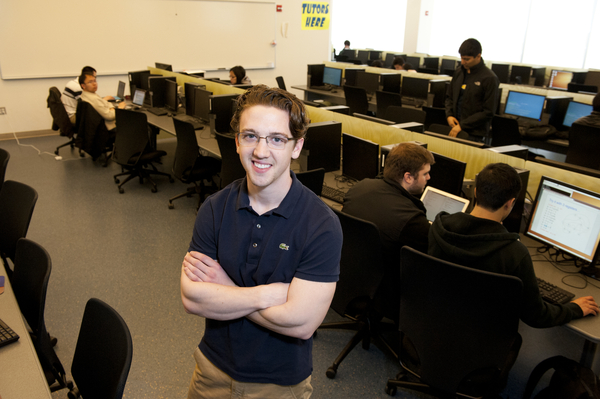Digital tools help uncover memes in literature

Irish author James Joyce surely wasn’t surfing the Web when he wrote the notoriously dense novel Finnegans Wake, published in 1939. But much of the book’s structure is intriguingly comparable to the memes that drive today’s online culture, according to senior English major Tom Murphy.
Murphy points out that the novel’s sprawling cast of characters takes after the constantly evolving stream of photos and text that populate users’ Facebook walls and Twitter feeds today. But comparing Joyce’s novel to the seemingly self-replicating meme culture—and specifically how ideas within it evolve and spread—can provide a macro-level look at a work that’s confounded readers and scholars alike for more than 70 years.
“You’re talking about a book that’s 800 or 900 pages long,” Murphy said. “It’s difficult to trudge through. The novel incorporates many different languages, and almost half of it is written in puns. To look at my idea—that the characters in Finnegans Wake existed very much like the way memes do today—in a traditional way would be a much harder task. But looking at it from this macro level, in an aggregate sense, makes looking at the book as a whole a much easier task.”
Murphy started taking this wide-lens approach to Finnegans Wake last fall when he took “Technologies of Text,” a digital humanities course taught by Ryan Cordell, an assistant professor of English. Cordell’s research has explored how stories and ideas went viral in the days long before the Internet, spreading across great distances through newspapers and periodicals rather than a series of online networks.
“I started tracking the characters in Finnegans Wake, and they reminded me more like memes than of the kind of characters you’d see in any other book,” said Murphy, who used digital tools introduced to him in the digital humanities class to analyze the text and confirm whether his observation proved accurate.
Murphy’s research shows that memes may not necessarily be unique to the Internet but instead represent a deeper way people tell and structure stories, relying on repeated imagery and text that evolves to meet the needs of new uses. Just as an online joke may change to meet the latest news item or pop culture happening, the appearances of Joyce’s characters evolve throughout Finnegans Wake to meet the novel’s storytelling needs.
The cast of characters in Finnegans Wake tends to behave in unusual ways, Murphy noted, with some frequently appearing in the company of others or in very specific contexts. Their appearance itself served as an opportunity for Joyce to comment upon plot or characters in a way beyond the traditional means of storytelling.
Murphy’s project relied in part on previous scholarly work that charts the circumstances and interactions of Joyce’s characters. But using new digital tools allowed the Northeastern student to investigate those connections more closely. For instance, Murphy utilized a program called Voyant for “distant reading,” a practice that looks at character appearances and interactions in any number of circumstances or combinations. He explained that distant reading inherently focuses more on structure than interpretation, an ideal tool for looking at the basic mechanics of a book like Finnegans Wake.
Murphy added that these powerful programs can do much more than gather data on one single book; they can allow scholars to look at vast topics like race or social mobility within a certain time period and rapidly conduct analyses that might otherwise take a lifetime of reading and research.
Upon completing the “Technologies in Text” course, Cordell encouraged Murphy to press further with his work. That led Murphy to present his research, “Memes, Distant Reading, and Finnegans Wake,” earlier this month at Re:Humanities, an undergraduate symposium exploring new media sponsored and organized by students at Swarthmore, Haverford, and Bryn Mawr colleges.
“I had never used these digital humanities tools before this fall, and they’ve completely changed the direction of what I’m able to accomplish in this field,” Murphy said. “It opens up new ways of looking at text that I never even thought was possible.”




